Cropland Productivity Evaluation: A 100 m Resolution Country Assessment Combining Earth Observation and Direct Measurements
Abstract
1. Introduction
2. Materials and Methods
2.1. Study Area
2.2. Databases
2.2.1. National Plot-Level Field Soil, Fertilization and Yield Databases (AIIR Field Database)
- -
- Basic data of the parcels (location, size, land user);
- -
- Soil taxonomical and laboratory analysis data (soil type and subtype, pH, texture, organic matter, nitrogen, phosphorus and potassium content);
- -
- Agricultural management data (crop type, yield, date of sowing, fertilization and harvest, fertilizer doses);
- -
- Crop type and yield data.
2.2.2. Remote Sensing Derived Biomass Productivity Indicators
2.2.3. Time Series Meteorological Data
2.2.4. Topographic Data
2.2.5. Land Use Data
2.2.6. Map Series of Soil Types and Soil Properties
2.3. Data Preparation
2.4. Assessment and Implementation Methods
2.4.1. Model Development
2.4.2. Spatial Implementation
3. Results
3.1. Model Development and Estimation Efficiency
3.2. Baseline Biomass Productivity Indices and Map for Croplands of Hungary
3.3. Soil and Climatic Determinants of Biomass Productivity in Hungary
4. Discussion
5. Conclusions
Author Contributions
Funding
Data Availability Statement
Acknowledgments
Conflicts of Interest
Appendix A
| Slope (%) | South, South-West | West, South-East | East, North-West | North-East | North |
|---|---|---|---|---|---|
| 1 | 1 | 1 | 1 | 1 | 0.98 |
| 2 | 1 | 1 | 1 | 0.98 | 0.96 |
| 3 | 1 | 1 | 0.98 | 0.96 | 0.94 |
| 4 | 1 | 0.98 | 0.96 | 0.94 | 0.92 |
| 5 | 0.98 | 0.96 | 0.94 | 0.92 | 0.9 |
| 6 | 0.96 | 0.94 | 0.92 | 0.9 | 0.88 |
| 7 | 0.94 | 0.92 | 0.9 | 0.88 | 0.86 |
| 8 | 0.92 | 0.9 | 0.88 | 0.86 | 0.84 |
| 9 | 0.9 | 0.88 | 0.86 | 0.84 | 0.82 |
| 10 | 0.88 | 0.86 | 0.84 | 0.82 | 0.8 |
| 11 | 0.86 | 0.84 | 0.82 | 0.8 | 0.78 |
| 12 | 0.84 | 0.82 | 0.8 | 0.78 | 0.76 |
| 13 | 0.82 | 0.8 | 0.78 | 0.76 | 0.74 |
| 14 | 0.8 | 0.78 | 0.76 | 0.74 | 0.72 |
| 15 | 0.78 | 0.76 | 0.74 | 0.72 | 0.7 |
| 16 | 0.76 | 0.74 | 0.72 | 0.7 | 0.68 |
| 17 | 0.74 | 0.72 | 0.7 | 0.68 | 0.66 |
| 18 | 0.72 | 0.7 | 0.68 | 0.66 | 0.64 |
| 19 | 0.7 | 0.68 | 0.66 | 0.64 | 0.62 |
| 20 | 0.68 | 0.66 | 0.64 | 0.62 | 0.6 |
| 21 | 0.66 | 0.64 | 0.62 | 0.6 | 0.58 |
| 22 | 0.64 | 0.62 | 0.6 | 0.58 | 0.56 |
| 23 | 0.62 | 0.6 | 0.58 | 0.56 | 0.54 |
| 24 | 0.6 | 0.58 | 0.56 | 0.54 | 0.52 |
| 25 | 0.58 | 0.56 | 0.54 | 0.52 | 0.5 |
| 25 | 0.56 | 0.54 | 0.52 | 0.5 | 0.48 |
References
- United Nations’ Agenda Sustainable Development Goals (SDGs). Available online: https://www.undp.org/sustainable-development-goals?utm_source=EN&utm_medium=GSR&utm_content=US_UNDP_PaidSearch_Brand_English&utm_campaign=CENTRAL&c_src=CENTRAL&c_src2=GSR&gclid=Cj0KCQjw2MWVBhCQARIsAIjbwoPU19Uvs4z3V0arAu_3QfBuDppDDaLFi5wfsb9husx4Hdj7FZ62lk (accessed on 4 December 2022).
- Keesstra, S.D.; Bouma, J.; Wallinga, J.; Tittonell, P.; Smith, P.; Cerdà, A.; Montanarella, L.; Quinton, J.N.; Pachepsky, Y.; Van Der Putten, W.H.; et al. The significance of soils and soil science towards realization of the United Nations sustainable development goals. SOIL 2016, 2, 111–128. [Google Scholar] [CrossRef]
- Bouma, J.; Montanarella, L.; Evanylo, G. The challenge for the soil science community to contribute to the implementation of the UN Sustainable Development Goals. Soil Use Manag. 2019, 35, 538–546. [Google Scholar] [CrossRef]
- Sims, N.C.; Newnham, G.J.; England, J.R.; Guerscham, J.; Cox, S.J.D.; Roxburgh, S.H.; Viscara Rossel, R.A.; Fritz, S.; Wheeler, I. Good Practice Guidance; SDG Indicator 15.3.1, Proportion of Land That Is Degraded Over Total Land Area Version 2.0; United Nations Conventions to Combat Desertification: Bonn, Germany, 2021. [Google Scholar]
- UNCCD SDG Indicator 15.3. Available online: https://knowledge.unccd.int/ldn/ldn-monitoring/sdg-indicator-1531 (accessed on 4 December 2022).
- McBride, R.A.; Bober, M.L. Quantified evaluation of agricultural soil capability at the local scale: A GIS-assisted case study from Ontario, Canada. Soil Use Manag. 1993, 9, 58–65. [Google Scholar] [CrossRef]
- Rossiter, D.G. A theoretical framework for land evaluation. Geoderma 1996, 72, 165–190. [Google Scholar] [CrossRef]
- FAO. A Framework for Land Evaluation; Food and Agriculture Organization: Rome, Italy, 1976; p. 32. [Google Scholar]
- Kumar, R.; Kalbende, A.R.; Landey, R.J. Soil Evaluation for Agricultural Land Use—II. Productivity Potential Appraisal. J. Indian Soc. Soil Sci. 1984, 32, 467–472. [Google Scholar]
- Schroers, J.O. Zur Entwicklung der Landnutzung auf Grenzstandorten in Abhängikeit Agrarmarktpolitischer, Agrarstrukturpolitischer und Produktions-Technologischer Rahmenbedingungen; Justus-Liebig-Universität: Gießen, Germany, 2006. [Google Scholar]
- Esch, E.; Mccann, K.; Kamm, C.; Arce, B.; Carroll, O.; Dolezal, A.; Mazzorato, A.; Noble, D.; Fraser, E.; Fryxell, J.; et al. Rising farm costs, marginal land cropping, and ecosystem service markets. Preprint 2021. [Google Scholar] [CrossRef]
- Esch, E.; MacDougall, A.S.; Esch, E.; MacDougall, A.S. More at the Margin: Leveraging ECOSYSTEM Services on Marginal Lands to Improve Agricultural Sustainability and Slow Trends of Farming Costs Outpacing Yield Gains; American Geophysical Union: Washington, DC, USA, 2018. [Google Scholar]
- Gopalakrishnan, G.; Negri, M.C.; Snyder, S.W. A Novel Framework to Classify Marginal Land for Sustainable Biomass Feedstock Production. J. Environ. Q. 2011, 40, 1593–1600. [Google Scholar] [CrossRef]
- Riquier, J.; Bramao, D.L.; Cornet, J.P. A new system of soil appraisal in terms of actual and potential productivity. FAO Soil Resour. Dev. Conserv. 1970, 38, 31–33. [Google Scholar]
- Sys, C. Land Evaluation. I-II-III; State University of Ghent: Ghent, Belgium, 1985. [Google Scholar]
- Van Lanen, H.A.J.; Broeke, M.J.D.H.; Bouma, J.; de Groot, W.J.M. A mixed qualitative/quantitative physical land evaluation methodology. Geoderma 1992, 55, 37–54. [Google Scholar] [CrossRef]
- Tóth, G. Evaluation of cropland productivity in Hungary with the D-e-Meter land evaluation system. Agrokémia Talajt 2011, 60, 161–174. [Google Scholar]
- Tóth, G.; Gardi, C.; Bódis, K.; Ivits, É.; Aksoy, E.; Jones, A.; Jeffrey, S.; Petursdottir, T.; Montanarella, L. Continental-scale assessment of provisioning soil functions in Europe. Ecol. Process. 2013, 2, 32. [Google Scholar] [CrossRef]
- Burrough, P.A. Fuzzy mathematical methods for soil survey and land evaluation. J. Soil Sci. 1989, 40, 477–492. [Google Scholar] [CrossRef]
- Godev, G.; Klestov, V. Statistical evaluation of soil fertility at given plant environment system. In Proceedings of the UNDP/FAO 472 Meeting of Panel of Experts on Land Productivity Evaluation, Sofia, Bulgaria, 27 September 1971. [Google Scholar]
- Trashliev, H.; Godev, G.; Krastanov, S.; Klevstov, A.; Kabakchiev, I.; Hershkovich, E.; Dilkov, D. Assessment of ecological conditions for wheat and maize in Bulgaria by means of multivariate regression analysis. In Proceedings of the UNDP/FAO 472 Meeting of Panel of Experts on Land Productivity Evaluation, Sofia, Bulgaria, 27 September 1971. [Google Scholar]
- Bonfante, A.; Terribile, F.; Bouma, J. Refining physical aspects of soil quality and soil health when exploring the effects of soil degradation and climate change on biomass production: An Italian case study. SOIL 2019, 5, 1–14. [Google Scholar] [CrossRef]
- Jeong, J.H.; Resop, J.P.; Mueller, N.D.; Fleisher, D.H.; Yun, K.; Butler, E.E.; Timlin, D.J.; Shim, K.M.; Gerber, J.S.; Reddy, V.R.; et al. Random Forests for Global and Regional Crop Yield Predictions. PLoS ONE 2016, 11, e0156571. [Google Scholar] [CrossRef]
- Roell, Y.E.; Beucher, A.; Møller, P.G.; Greve, M.B.; Greve, M.H. Comparing a Random Forest Based Prediction of Winter Wheat Yield to Historical Yield Potential. Agronomy 2020, 10, 395. [Google Scholar] [CrossRef]
- Cheng, M.; Jiao, X.; Shi, L.; Penuelas, J.; Kumar, L.; Nie, C.; Wu, T.; Liu, K.; Wu, W.; Jin, X. High-resolution crop yield and water productivity dataset generated using random forest and remote sensing. Sci. Data 2022, 9, 641. [Google Scholar] [CrossRef] [PubMed]
- Guo, Y.; Xia, H.; Zhao, X.; Qiao, L.; Du, Q.; Qin, Y. Early-season mapping of winter wheat and garlic in Huaihe basin using Sentinel-1/2 and Landsat-7/8 imagery. IEEE J. Sel. Top. Appl. Earth Obs. Remote Sens. 2022, 1–10. [Google Scholar] [CrossRef]
- Breiman, L. Random Forests. Mach. Learn. 2001, 45, 5–32. [Google Scholar] [CrossRef]
- Cutler, A.; Cutler, D.R.; Stevens, J.R. Random Forests. In Ensemble Machine Learning; Springer: Boston, MA, USA, 2012; pp. 157–175. [Google Scholar] [CrossRef]
- Farkas, J.Z.; Lennert, J. Modelling and predicting of the land use change in Hungary. In Climate Change—Society—Economy: Long-Term Processes and Trends in Hungary; Czirfusz, M., Hoyk, E., Suvák, A., Eds.; Publikon: Pécs, Hungary, 2015; pp. 193–221. ISBN 978-615-5457-62-3. [Google Scholar]
- EEA. Corine Land Cover (CLC) 2018; EEA: Copenhagen, Denmark, 2018. [Google Scholar]
- Kocsis, M.; Tóth, G.; Berényi-Üveges, J.; Makó, A. Presentation of soil data from the National Pedological and Crop Production Database (NPCPD) and investigations on spatial representativeness. Agrokémia Talajt. 2014, 63, 223–248. [Google Scholar] [CrossRef]
- Stefanovits, P.; Michéli, E. Talajgenetika, Talajosztályozás II; Gödöllői Agrártudományi Egyetem: Gödöllő, Hungary, 1989. [Google Scholar]
- FAO. World Reference Base for Soil Resources. In International Soil Classification System for Naming Soils and Creating Legends for Soil Maps; FAO: Rome, Italy, 2015. [Google Scholar]
- Jin, H.; Eklundh, L. A physically based vegetation index for improved monitoring of plant phenology. Remote Sens. Environ. 2014, 152, 512–525. [Google Scholar] [CrossRef]
- NASA Modis Dataset. Available online: https://modis.gsfc.nasa.gov/ (accessed on 4 December 2022).
- He, M.; Kimball, J.S.; Maneta, M.P.; Maxwell, B.D.; Moreno, A.; Beguería, S.; Wu, X. Regional Crop Gross Primary Productivity and Yield Estimation Using Fused Landsat-MODIS Data. Remote Sens. 2018, 10, 372. [Google Scholar] [CrossRef]
- Dobor, L.; Barcza, Z.; Hlásny, T.; Havasi; Horváth, F.; Ittzés, P.; Bartholy, J. Bridging the gap between climate models and impact studies: The FORESEE Database. Geosci. Data J. 2015, 2, 1–11. [Google Scholar] [CrossRef]
- SRTM Shuttle Radar Topography Mission (SRTM) Global. Available online: https://portal.opentopography.org/datasetMetadata?otCollectionID=OT.042013.4326.1 (accessed on 4 December 2022).
- Rabus, B.; Eineder, M.; Roth, A.; Bamler, R. The shuttle radar topography mission—A new class of digital elevation models acquired by spaceborne radar. ISPRS J. Photogramm. Remote Sens. 2003, 57, 241–262. [Google Scholar] [CrossRef]
- Józsa, E.; Fábián, S.Á.; Kovács, M. An evaluation of EU-DEM in comparison with ASTER GDEM, SRTM and contour-based DEMs over the Eastern Mecsek Mountains. Hungarian Geogr. Bull. 2014, 63, 401–423. [Google Scholar] [CrossRef]
- Pásztor, L.; Laborczi, A.; Bakacsi, Z.; Szabó, J.; Illés, G. Compilation of a national soil-type map for Hungary by sequential classification methods. Geoderma 2018, 311, 93–108. [Google Scholar] [CrossRef]
- Pásztor, L.; Laborczi, A.; Takács, K.; Szatmári, G.; Dobos, E.; Illés, G.; Bakacsi, Z.; Szabó, J. Compilation of novel and renewed, goal oriented digital soil maps using geostatistical and data mining tools. Hungarian Geogr. Bull. 2015, 64, 49–64. [Google Scholar] [CrossRef]
- Pásztor, L.; Laborczi, A.; Takács, K.; Szatmári, G.; Fodor, N.; Illés, G.; Farkas-Iványi, K.; Bakacsi, Z.; Szabó, J. Compilation of Functional Soil Maps for the Support of Spatial Planning and Land Management in Hungary. In Soil Mapping and Process Modeling for Sustainable Land Use Management; Pereira, P., Brevik, E.C., Munoz-Rojas, M., Miller, B.A., Eds.; Elsevier: Amsterdam, The Netherlands, 2017; pp. 293–317. [Google Scholar]
- Pásztor, L.; Laborczi, A.; Takács, K.; Illés, G.; Szabó, J.; Szatmári, G. Progress in the elaboration of GSM conform DSM products and their functional utilization in Hungary. Geoderma Reg. 2020, 21, e00269. [Google Scholar] [CrossRef]
- Baranyai, F.; Fekete, A.; Kovács, I. A Magyarországi Tápanyag-Vizsgálatok Eredményei; Mezőgazdasági Kiadó: Budapest, Hungary, 1987; pp. 8–79. [Google Scholar]
- KSH Központi Statisztikai Hivatal (Central Statistical Office). Available online: https://www.ksh.hu (accessed on 4 December 2022).
- Farmanov, N.; Amankulova, K.; Szatmari, J.; Sharifi, A.; Abbasi-Moghadam, D.; Mirhossein-Nejad, M.; Mucsi, L. Crop Type Classification by DESIS Hyperspectral Imagery and Machine Learning Algorithms. IEEE J. Sel. Top. Appl. Earth Obs. Remote Sens. 2023, 16, 1576–1588. [Google Scholar] [CrossRef]
- Wright, M.N.; Ziegler, A. Ranger: A Fast Implementation of Random Forests for High Dimensional Data in C++ and R. J. Stat. Softw. 2017, 77, 1–17. [Google Scholar] [CrossRef]
- Mezőgazdasági és Élelmezésügyi Minisztérium (MÉM) Táblázatok a Földértékelés Végrehajtásához; MÉM: Budapest, Hungary, 1982.
- Fekete, Z. Direktívák a Gyakorlati Földértékeléshez; Mezőgazdasági Kiadó: Budapest, Hungary, 1965. [Google Scholar]
- Fórizsné, J.; Máté, F.; Stefanovits, P. Talajbonitáció—Földértékelés. MTA Agrártudományok Osztályának Közleményei 1972, 30, 359–378. [Google Scholar]
- Hermann, T.; Kismányoky, T.; Tóth, G. A humuszellátottság hatása a kukorica (Zea mays L.) termésére csernozjom és barna erdőtalajú termőhelyeken, különböző évjáratokban. Növénytermelés 2014, 63, 1–18. [Google Scholar]
- Máté, F. Megjegyzések a talajok termékenységük szerinti osztályozásához. Agrokémia Talajt. 1960, 9, 419–426. [Google Scholar]
- Tóth, G.; Máté, F. Jellegzetes dunántúli talajok főbb növényenkénti relatív termékenysége. Agrokémia Talajt. 1999, 48, 172. [Google Scholar]
- Nia, V.P.; Davison, A.C. High-Dimensional Bayesian Clustering with Variable Selection: The R Package bclust. J. Stat. Softw. 2012, 47, 1–22. [Google Scholar] [CrossRef]
- Willmott, C.; Matsuura, K. Advantages of the mean absolute error (MAE) over the root mean square error (RMSE) in assessing average model performance. Clim. Res. 2005, 30, 79–82. [Google Scholar] [CrossRef]
- De Myttenaere, A.; Golden, B.; Grand, B.L.; Rossi, F. Mean Absolute Percentage Error for regression models. Neurocomputing 2016, 192, 38–48. [Google Scholar] [CrossRef]
- Seddaiu, G.; Iocola, I.; Farina, R.; Orsini, R.; Iezzi, G.; Roggero, P.P. Long term effects of tillage practices and N fertilization in rainfed Mediterranean cropping systems: Durum wheat, sunflower and maize grain yield. Eur. J. Agron. 2016, 77, 166–178. [Google Scholar] [CrossRef]
- Sadras, V.O.; Calviño, P.A. Quantification of Grain Yield Response to Soil Depth in Soybean, Maize, Sunflower, and Wheat. Agron. J. 2001, 93, 577–583. [Google Scholar] [CrossRef]
- Feng, P.; Wang, B.; Liu, D.L.; Waters, C.; Xiao, D.; Shi, L.; Yu, Q. Dynamic wheat yield forecasts are improved by a hybrid approach using a biophysical model and machine learning technique. Agric. For. Meteorol. 2020, 285–286, 107922. [Google Scholar] [CrossRef]
- Kheir, A.M.S.; Ammar, K.A.; Amer, A.; Ali, M.G.M.; Ding, Z.; Elnashar, A. Machine learning-based cloud computing improved wheat yield simulation in arid regions. Comput. Electron. Agric. 2022, 203, 107457. [Google Scholar] [CrossRef]
- Reeves, M.C.; Zhao, M.; Running, S.W. Usefulness and limits of MODIS GPP for estimating wheat yield. Int. J. Remote Sens. 2007, 26, 1403–1421. [Google Scholar] [CrossRef]
- Mishra, U.; Torn, M.S.; Fingerman, K. Miscanthus biomass productivity within US croplands and its potential impact on soil organic carbon. GCB Bioenergy 2013, 5, 391–399. [Google Scholar] [CrossRef]
- Xie, X.; Li, A.; Tian, J.; Wu, C.; Jin, H. A fine spatial resolution estimation scheme for large-scale gross primary productivity (GPP) in mountain ecosystems by integrating an eco-hydrological model with the combination of linear and non-linear downscaling processes. J. Hydrol. 2023, 616, 128833. [Google Scholar] [CrossRef]
- Sabetraftar, K.; Mackey, B.; Croke, B. Sensitivity of modelled gross primary productivity to topographic effects on surface radiation: A case study in the Cotter River Catchment, Australia. Ecol. Modell. 2011, 222, 795–803. [Google Scholar] [CrossRef]
- Kern, A.; Barcza, Z.; Marjanović, H.; Árendás, T.; Fodor, N.; Bónis, P.; Bognár, P.; Lichtenberger, J. Statistical modelling of crop yield in Central Europe using climate data and remote sensing vegetation indices. Agric. For. Meteorol. 2018, 260–261, 300–320. [Google Scholar] [CrossRef]
- Vannoppen, A.; Gobin, A. Estimating Farm Wheat Yields from NDVI and Meteorological Data. Agron. 2021, 11, 946. [Google Scholar] [CrossRef]
- Debreczeni, B.; Németh, T.; Tóth, G. Nutrient factor of land quality. In Land Evaluation and Land Use Information; Gaál, Z., Máté, F., Tóth, G., Eds.; Veszprémi Egyetem: Keszthely, Hungary, 2003; pp. 39–48. ISBN 963949525. [Google Scholar]
- Farooq, M.; Bramley, H.; Palta, J.A.; Siddique, K.H.M. Heat Stress in Wheat during Reproductive and Grain-Filling Phases. Crit. Rev. Plant Sci. 2011, 30, 491–507. [Google Scholar] [CrossRef]
- Hatfield, J.L.; Boote, K.J.; Kimball, B.A.; Ziska, L.H.; Izaurralde, R.C.; Ort, D.; Thomson, A.M.; Wolfe, D. Climate Impacts on Agriculture: Implications for Crop Production. Agron. J. 2011, 103, 351–370. [Google Scholar] [CrossRef]
- Lobell, D.B.; Schlenker, W.; Costa-Roberts, J. Climate trends and global crop production since 1980. Science 2011, 333, 616–620. [Google Scholar] [CrossRef]
- Lobell, D.B.; Cahill, K.N.; Field, C.B. Historical effects of temperature and precipitation on California crop yields. Clim. Change 2007, 81, 187–203. [Google Scholar] [CrossRef]
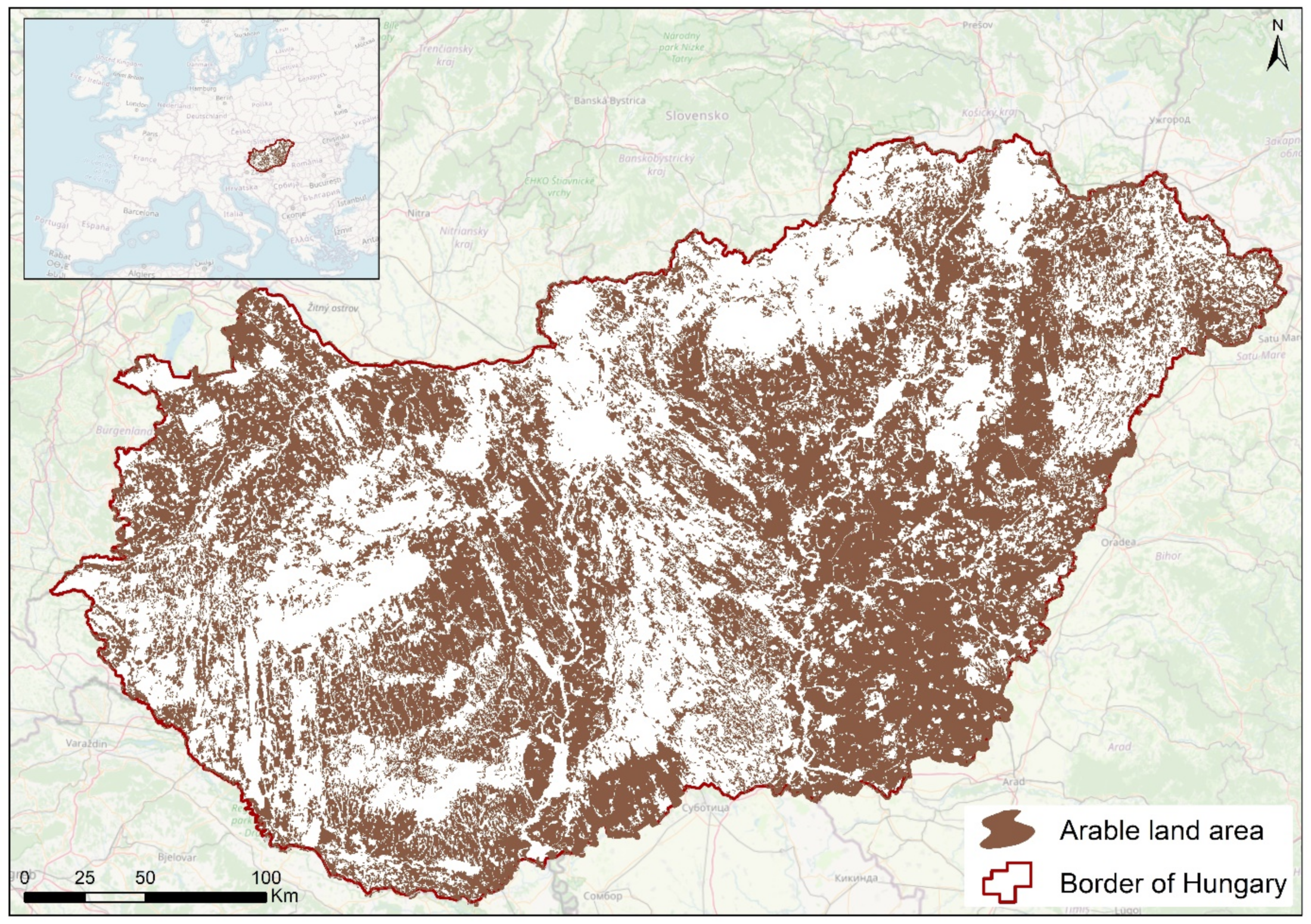
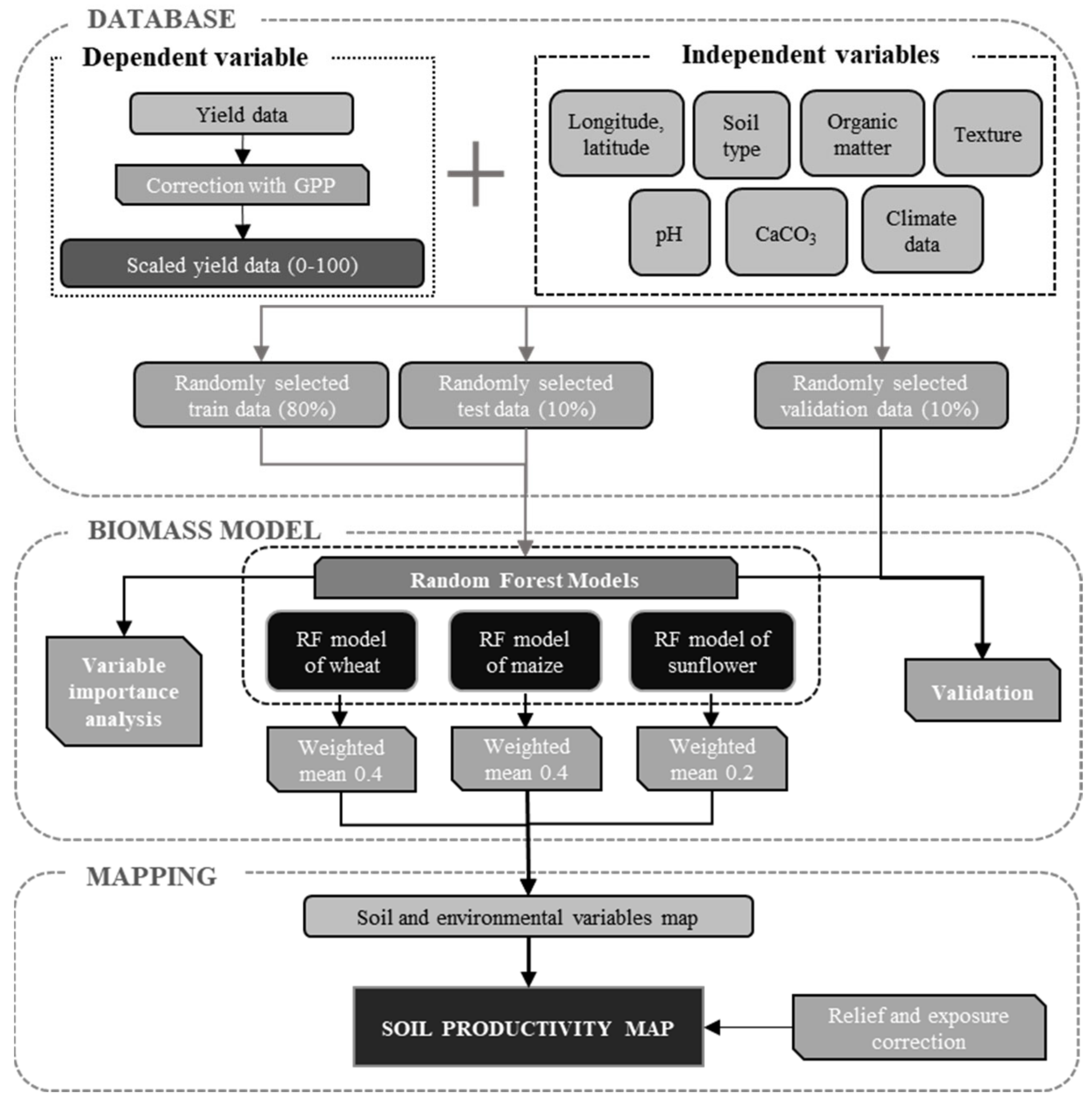
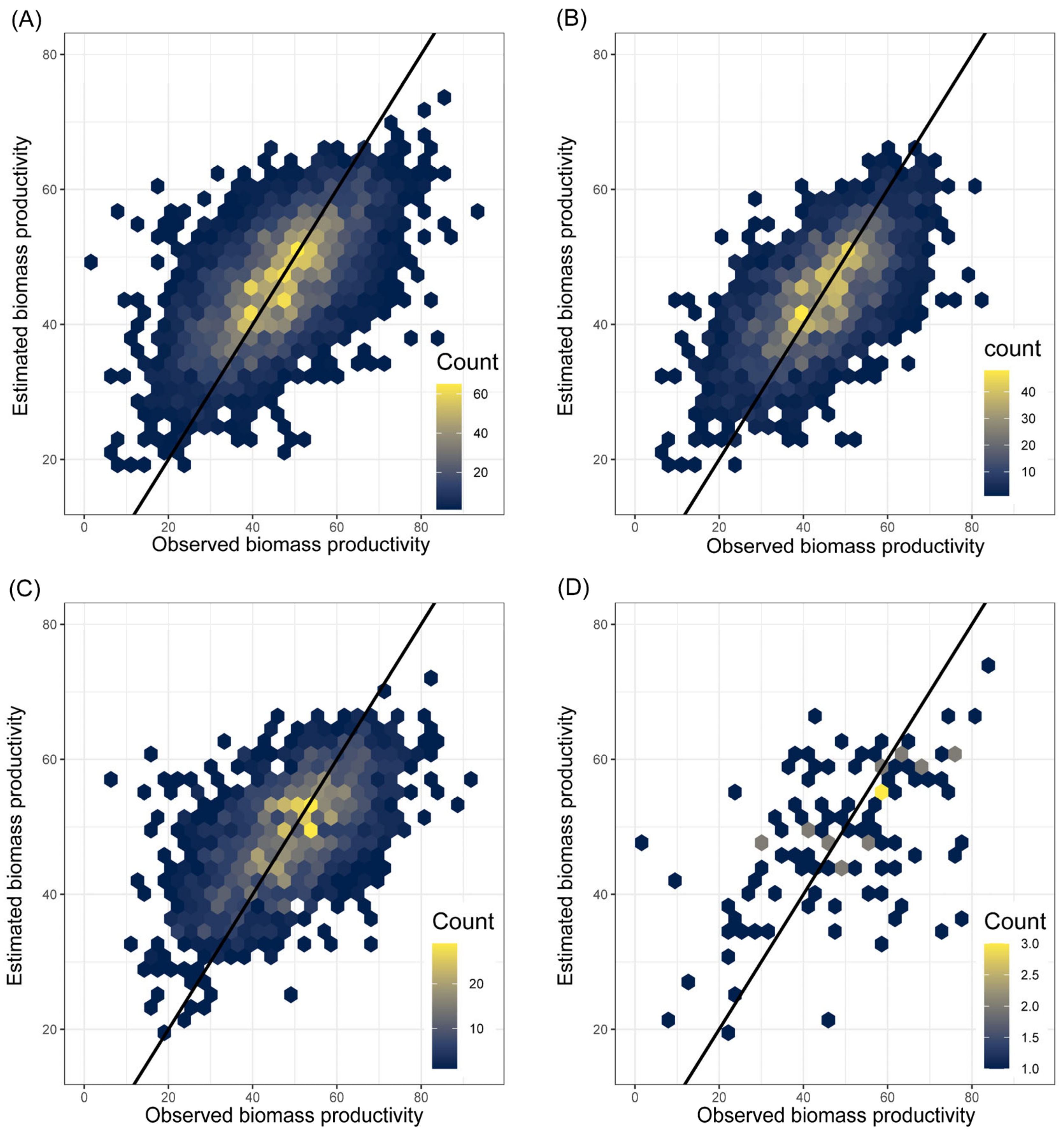
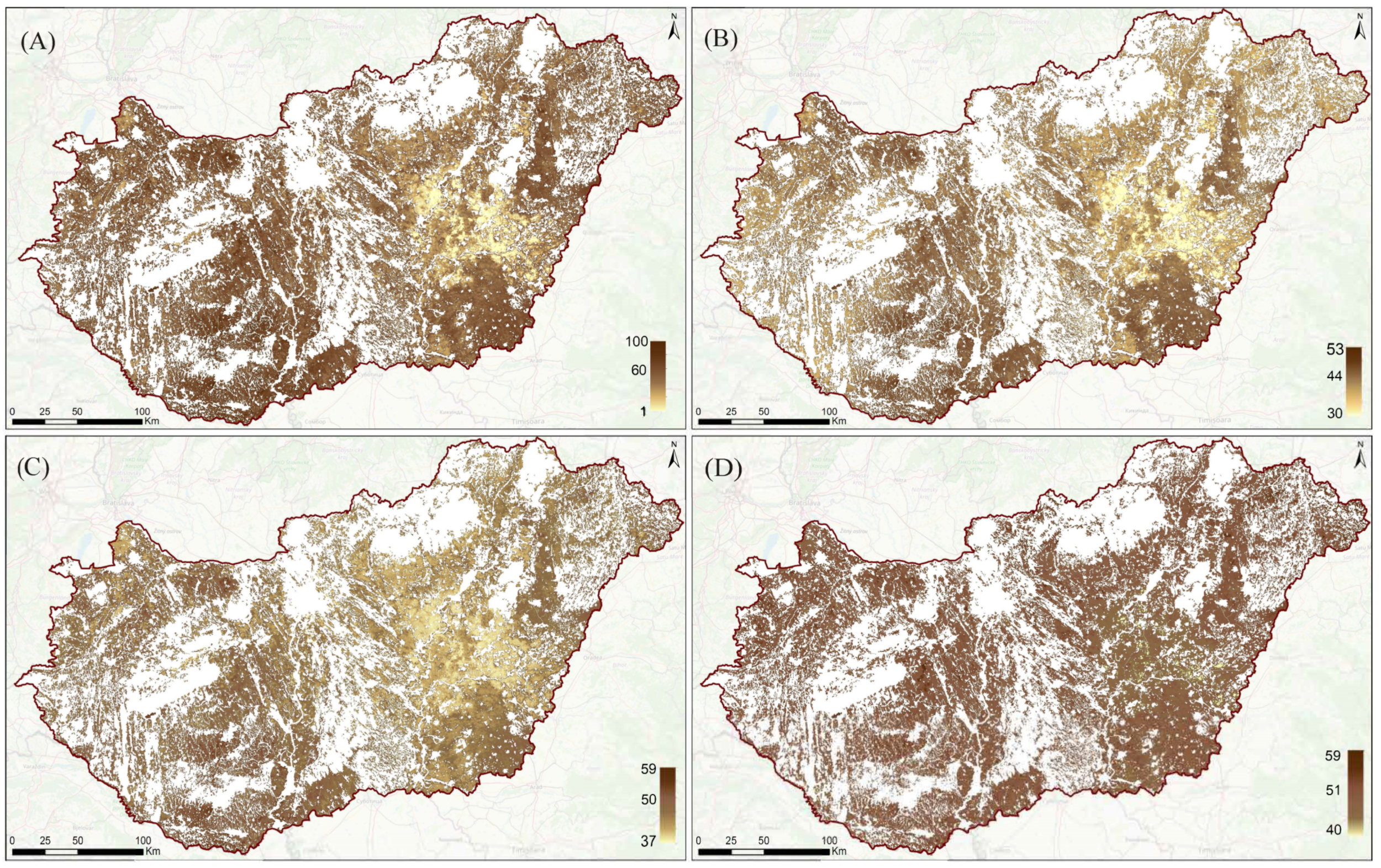
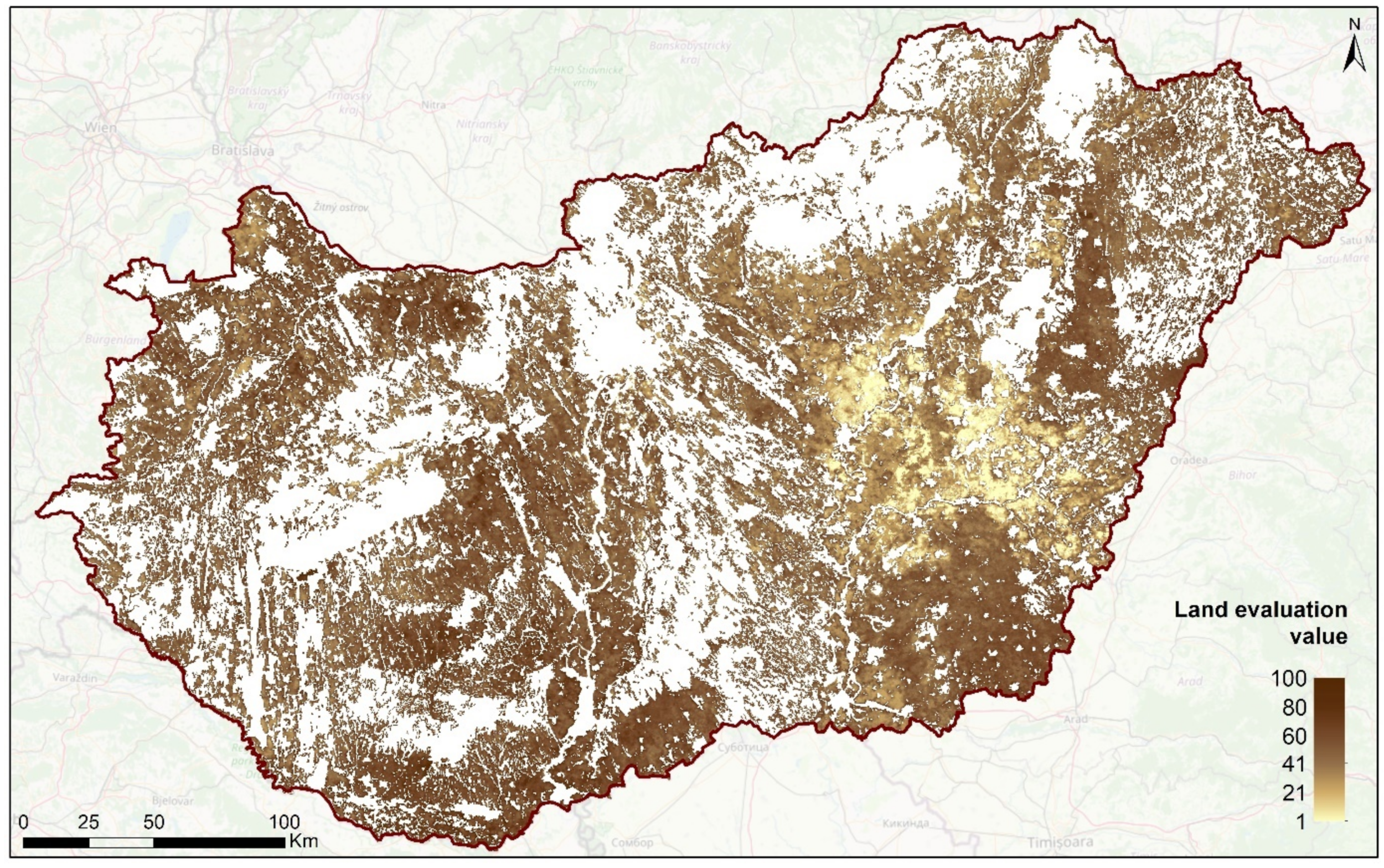
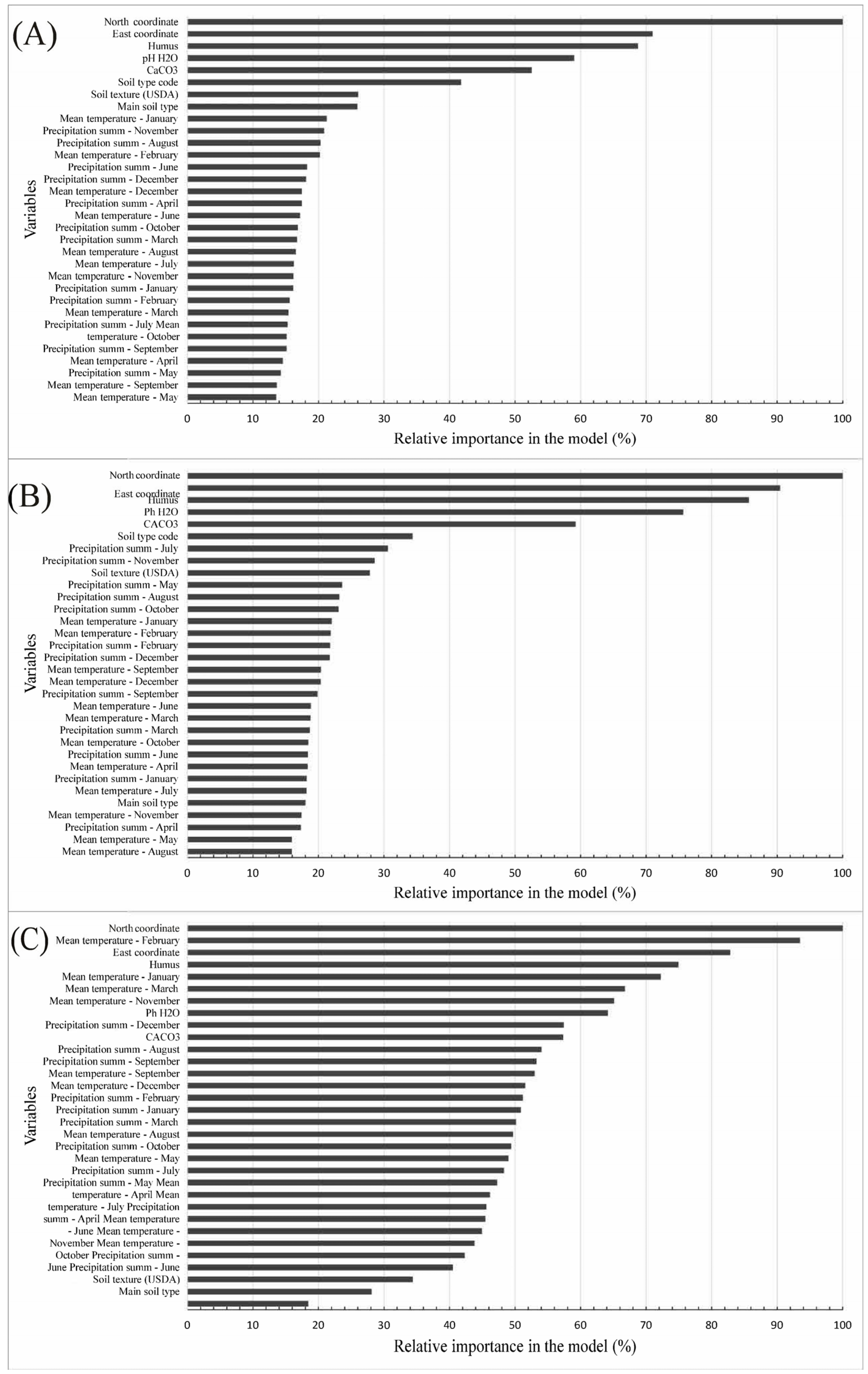
| Soil Taxonomical Unit of Major Agricultural Soils | No. of Parcels Covered | Area (ha) | Area (%) | |
|---|---|---|---|---|
| Hungarian classification | WRB 2014 | |||
| Lessivated brown forest soil (non-podzolic) | Haplic Luvisol | 11,062 | 385,048 | 10.06 |
| Raman-type brown forest soil | Haplic Cambisol | 6567 | 270,239 | 7.06 |
| Rust-brown sandy forest soil | Arenic Cambisol | 2988 | 114,872 | 3 |
| Typical calcareous chernozem | Haplic Chernozems | 3792 | 228,240 | 5.96 |
| Great Plains calcareous chernozem | Haplic Chernozems | 2042 | 120,123 | 3.14 |
| Carbonated meadow chernozem | Gleyic Chernozems | 5540 | 330,200 | 8.63 |
| Non-carbonated meadow chernozem | Luvic Chernozems | 2021 | 108,149 | 2.83 |
| Carbonated meadow soil | Calcic Vertisols | 3952 | 184,853 | 4.83 |
| Non-carbonated meadow soil | Haplic Vertisols | 3460 | 151,394 | 3.96 |
| Carbonated alluvial meadow soil | Gleyic Fluvisols | 3129 | 142,535 | 3.73 |
| Non-carbonated alluvial meadow soil | Dystric Fluvisols | 4658 | 179,101 | 4.68 |
| Carbonated humic alluvial soil | Calcaric Fluvisols | 1210 | 51,720 | 1.35 |
| Non-carbonated humic alluvial soil | Dystric Fluvisols | 1584 | 50,789 | 1.33 |
| Carbonated humic sandy soil | Calcaric Cambisols | 3714 | 138,044 | 3.61 |
| Non-carbonated humic sandy soil | Dystric Cambisols | 2458 | 75,656 | 1.98 |
| major soils in total | 58,177 | 2,530,963 | 66.2 | |
| other soils | 28,517 | 1,295,467 | 33.8 | |
| ∑ | 86,695 | 3,826,430 | 100 | |
| R2 | R | MAPE (%) | MAE | N | |
|---|---|---|---|---|---|
| All cropland | 0.4 | 0.63 | 19.28 | 7.33 | 4381 |
| Wheat | 0.41 | 0.64 | 18.06 | 6.78 | 2631 |
| Maize | 0.35 | 0.59 | 19.17 | 7.93 | 1646 |
| Sunflower | 0.27 | 0.52 | 29.81 | 11.7 | 104 |
Disclaimer/Publisher’s Note: The statements, opinions and data contained in all publications are solely those of the individual author(s) and contributor(s) and not of MDPI and/or the editor(s). MDPI and/or the editor(s) disclaim responsibility for any injury to people or property resulting from any ideas, methods, instructions or products referred to in the content. |
© 2023 by the authors. Licensee MDPI, Basel, Switzerland. This article is an open access article distributed under the terms and conditions of the Creative Commons Attribution (CC BY) license (https://creativecommons.org/licenses/by/4.0/).
Share and Cite
Csikós, N.; Szabó, B.; Hermann, T.; Laborczi, A.; Matus, J.; Pásztor, L.; Szatmári, G.; Takács, K.; Tóth, G. Cropland Productivity Evaluation: A 100 m Resolution Country Assessment Combining Earth Observation and Direct Measurements. Remote Sens. 2023, 15, 1236. https://doi.org/10.3390/rs15051236
Csikós N, Szabó B, Hermann T, Laborczi A, Matus J, Pásztor L, Szatmári G, Takács K, Tóth G. Cropland Productivity Evaluation: A 100 m Resolution Country Assessment Combining Earth Observation and Direct Measurements. Remote Sensing. 2023; 15(5):1236. https://doi.org/10.3390/rs15051236
Chicago/Turabian StyleCsikós, Nándor, Brigitta Szabó, Tamás Hermann, Annamária Laborczi, Judit Matus, László Pásztor, Gábor Szatmári, Katalin Takács, and Gergely Tóth. 2023. "Cropland Productivity Evaluation: A 100 m Resolution Country Assessment Combining Earth Observation and Direct Measurements" Remote Sensing 15, no. 5: 1236. https://doi.org/10.3390/rs15051236
APA StyleCsikós, N., Szabó, B., Hermann, T., Laborczi, A., Matus, J., Pásztor, L., Szatmári, G., Takács, K., & Tóth, G. (2023). Cropland Productivity Evaluation: A 100 m Resolution Country Assessment Combining Earth Observation and Direct Measurements. Remote Sensing, 15(5), 1236. https://doi.org/10.3390/rs15051236











